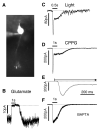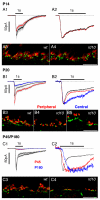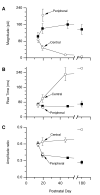Differential loss and preservation of glutamate receptor function in bipolar cells in the rd10 mouse model of retinitis pigmentosa
- PMID: 19385989
- PMCID: PMC2818147
- DOI: 10.1111/j.1460-9568.2009.06728.x
Differential loss and preservation of glutamate receptor function in bipolar cells in the rd10 mouse model of retinitis pigmentosa
Abstract
Photoreceptor degenerations can trigger morphological alterations in second-order neurons, however, the functional implications of such changes are not well known. We conducted a longitudinal study, using whole-cell patch-clamp, immunohistochemistry and electron microscopy to correlate physiological with anatomical changes in bipolar cells of the rd10 mouse - a model of autosomal recessive retinitis pigmentosa. Rod bipolar cells (RBCs) showed progressive changes in mGluR6-induced currents with advancing rod photoreceptor degeneration. Significant changes in response amplitude and kinetics were observed as early as postnatal day (P)20, and by P45 the response amplitudes were reduced by 91%, and then remained relatively stable until 6 months. These functional changes correlated with the loss of rod photoreceptors and mGluR6 receptor expression. Moreover, we showed that RBCs make transient ectopic connections with cones during progression of the disease. At P45, ON-cone bipolar cells (ON-CBCs) retain mGluR6 responses for longer periods than the RBCs, but by about 6 months these cells also strongly downregulate mGluR6 expression. We propose that the relative longevity of mGluR6 responses in CBCs is due to the slower loss of the cones. In contrast, ionotropic glutamate receptor expression and function in OFF-CBCs remains normal at 6 months despite the loss of synaptic input from cones. Thus, glutamate receptor expression is differentially regulated in bipolar cells, with the metabotropic receptors being absolutely dependent on synaptic input. These findings define the temporal window over which bipolar cells may be receptive to photoreceptor repair or replacement.
Figures






Similar articles
-
Expression of genes encoding glutamate receptors and transporters in rod and cone bipolar cells of the primate retina determined by single-cell polymerase chain reaction.Mol Vis. 2007 Nov 28;13:2194-208. Mol Vis. 2007. PMID: 18087239
-
Neural reprogramming in retinal degeneration.Invest Ophthalmol Vis Sci. 2007 Jul;48(7):3364-71. doi: 10.1167/iovs.07-0032. Invest Ophthalmol Vis Sci. 2007. PMID: 17591910 Free PMC article.
-
Long-term preservation of cone photoreceptors and visual acuity in rd10 mutant mice exposed to continuous environmental enrichment.Mol Vis. 2014 Nov 5;20:1545-56. eCollection 2014. Mol Vis. 2014. PMID: 25489227 Free PMC article.
-
Progression of neuronal and synaptic remodeling in the rd10 mouse model of retinitis pigmentosa.J Comp Neurol. 2010 Jun 1;518(11):2071-89. doi: 10.1002/cne.22322. J Comp Neurol. 2010. PMID: 20394059 Free PMC article.
-
Regulation of ON bipolar cell activity.Prog Retin Eye Res. 2008 Jul;27(4):450-63. doi: 10.1016/j.preteyeres.2008.03.003. Epub 2008 Apr 6. Prog Retin Eye Res. 2008. PMID: 18524666 Free PMC article. Review.
Cited by
-
Orchestrating Blood Flow in the Retina: Interpericyte Tunnelling Nanotube Communication.Results Probl Cell Differ. 2024;73:229-247. doi: 10.1007/978-3-031-62036-2_11. Results Probl Cell Differ. 2024. PMID: 39242382 Review.
-
Enhanced restoration of visual code after targeting ON bipolar cells compared with retinal ganglion cells with optogenetic therapy.Mol Ther. 2025 Mar 5;33(3):1264-1281. doi: 10.1016/j.ymthe.2025.01.030. Epub 2025 Jan 17. Mol Ther. 2025. PMID: 39825567 Free PMC article.
-
AAV Induced Expression of Human Rod and Cone Opsin in Bipolar Cells of a Mouse Model of Retinal Degeneration.Biomed Res Int. 2021 Feb 9;2021:1-8. doi: 10.1155/2021/4014797. Biomed Res Int. 2021. PMID: 35465048 Free PMC article.
-
Impairment of photoreceptor ribbon synapses in a novel Pomt1 conditional knockout mouse model of dystroglycanopathy.Sci Rep. 2018 Jun 4;8(1):8543. doi: 10.1038/s41598-018-26855-x. Sci Rep. 2018. PMID: 29867208 Free PMC article.
-
Inner retinal preservation in the photoinducible I307N rhodopsin mutant mouse, a model of autosomal dominant retinitis pigmentosa.J Comp Neurol. 2020 Jun 15;528(9):1502-1522. doi: 10.1002/cne.24838. Epub 2019 Dec 18. J Comp Neurol. 2020. PMID: 31811649 Free PMC article.
References
-
- Bainbridge JW, Tan MH, Ali RR. Gene therapy progress and prospects: the eye. Gene Ther. 2006;13:1191–1197. - PubMed
-
- Barhoum R, Martinez-Navarrete G, Corrochano S, Germain F, Fernandez-Sanchez L, de la Rosa EJ, de la Villa P, Cuenca N. Functional and structural modifications during retinal degeneration in the rd10 mouse. Neuroscience. 2008;155:698–713. - PubMed
-
- Berntson A, Smith RG, Taylor WR. Postsynaptic calcium feedback between rods and rod bipolar cells in the mouse retina. Vis Neurosci. 2004;21:913–924. - PubMed
-
- Blanks JC, Adinolfi AM, Lolley RN. Photoreceptor degeneration and synaptogenesis in retinal-degenerative (rd) mice. J Comp Neurol. 1974;156:95–106. - PubMed
Publication types
MeSH terms
Substances
Grants and funding
LinkOut - more resources
Full Text Sources
Molecular Biology Databases
Miscellaneous

